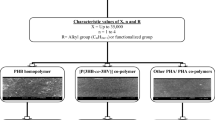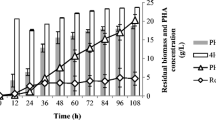Abstract
The copolymer poly(3-hydroxybutyrate-co-3-hydroxyhexanoate) [P(HB-co-HHx)] has the potential to serve as a biodegradable tissue engineering material. However, the production of this kind of copolymer still suffers from high cost and uncertainty. We describe here the design of metabolic pathways to synthesize P(HB-co-HHx) directly from glucose using recombinant Escherichia coli. By combining the BktB-dependent condensation pathway with the inverted β-oxidation cycle pathway, we were able to synthesize a P(HB-co-HHx) copolymer with a 10 mol% HHx fraction in recombinant E. coli. After optimizing the host strain and employing thioesterase mutant strains, the engineered E. coli produced 12.9 wt% P(HB-co-HHx) with a 13.2 mol% 3HHx fraction.


Similar content being viewed by others
References
Anderson AJ, Dawes EA (1990) Occurrence, metabolism, metabolic role, and industrial uses of bacterial polyhydroxyalkanoates. Microbiol Rev 54:450–472
Bluhm TL, Hamer GK, Marchessault RH, Fyfe CA, Veregin RP, Bluhm TL, Hamer GK, Marchessault RH, Fyfe CA, Veregin RP (1986) Isodimorphism in bacterial poly(β-hydroxybutyrate-co-β-hydroxyvalerate). Macromolecules 19:2871–2876
Budde CF, Riedel SL, Hubner F, Risch S, Popovic MK, Rha C, Sinskey AJ (2011a) Growth and polyhydroxybutyrate production by Ralstonia eutropha in emulsified plant oil medium. Appl Microbiol Biotechnol 89:1611–1619. doi:10.1007/s00253-011-3102-0
Budde CF, Riedel SL, Willis LB, Rha C, Sinskey AJ (2011b) Production of poly(3-hydroxybutyrate-co-3-hydroxyhexanoate) from plant oil by engineered Ralstonia eutropha strains. Appl Environ Microbiol 77:2847–2854. doi:10.1128/AEM. 02429-10
Chen GQ, Zhang G, Park SJ, Lee SY (2001) Industrial scale production of poly(3-hydroxybutyrate-co-3-hydroxyhexanoate). Appl Microbiol Biotechnol 57:50–55
Chen Q, Wang Q, Wei G, Liang Q, Qi Q (2011) Production in Escherichia coli of poly(3-hydroxybutyrate-co-3-hydroxyvalerate) with differing monomer compositions from unrelated carbon sources. Appl Environ Microbiol 77:4886–4893. doi:10.1128/AEM. 00091-11
Clomburg JM, Vick JE, Blankschien MD, Rodriguez-Moya M, Gonzalez R (2012) A synthetic biology approach to engineer a functional reversal of the beta-oxidation cycle. ACS Synth Biol 1:541–554. doi:10.1021/sb3000782
Dekishima Y, Lan EI, Shen CR, Cho KM, Liao JC (2011) Extending carbon chain length of 1-butanol pathway for 1-hexanol synthesis from glucose by engineered Escherichia coli. J Am Chem Soc 133:11399–11401. doi:10.1021/ja203814d
Doi Y, Kitamura S, Abe H (1995) Microbial synthesis and characterization of poly (3-hydroxybutyrate-co-3-hydroxyhexanoate). Macromolecules 28:4822–4828
Feng L, Watanabe T, Wang Y, Kichise T, Fukuchi T, Chen GQ, Doi Y, Inoue Y (2002) Studies on comonomer compositional distribution of bacterial poly(3-hydroxybutyrate-co-3-hydroxyhexanoate)s and thermal characteristics of their factions. Biomacromolecules 3:1071–1077
Fukui T, Doi Y (1997) Cloning and analysis of the poly(3-hydroxybutyrate-co-3-hydroxyhexanoate) biosynthesis genes of Aeromonas caviae. J Bacteriol 179:4821–4830
Fukui T, Shiomi N, Doi Y (1998) Expression and characterization of (R)-specific enoyl coenzyme A hydratase involved in polyhydroxyalkanoate biosynthesis by Aeromonas caviae. J Bacteriol 180:667–673
Fukui T, Yokomizo S, Kobayashi G, Doi Y (1999) Co-expression of polyhydroxyalkanoate synthase and (R)-enoyl-CoA hydratase genes of Aeromonas caviae establishes copolyester biosynthesis pathway in Escherichia coli. FEMS Microbiol Lett 170:69–75
Fukui T, Abe H, Doi Y (2002) Engineering of Ralstonia eutropha for production of poly(3-hydroxybutyrate-co-3-hydroxyhexanoate) from fructose and solid-state properties of the copolymer. Biomacromolecules 3:618–624
Insomphun C, Xie H, Mifune J, Kawashima Y, Orita I, Nakamura S, Fukui T (2014) Improved artificial pathway for biosynthesis of poly(3-hydroxybutyrate-co-3-hydroxyhexanoate) with high C-monomer composition from fructose in Ralstonia eutropha. Metab Eng 27C:38–45. doi:10.1016/j.ymben.2014.10.006
Kahar P, Tsuge T, Taguchi K, Doi Y (2004) High yield production of polyhydroxyalkanoates from soybean oil by Ralstonia eutropha and its recombinant strain. Polym Degrad Stab 83:79–86
Kichise T, Fukui T, Yoshida Y, Doi Y (1999) Biosynthesis of polyhydroxyalkanoates (PHA) by recombinant Ralstonia eutropha and effects of PHA synthase activity on in vivo PHA biosynthesis. Int J Biol Macromol 25:69–77
Kobayashi G, Shiotani T, Shima Y, Doi Y (1994) Biosynthesis and characterization of poly (3-hydroxybutyrate-co-3-hydroxyhexanoate) from oils and fats by Aeromonas sp. OL-338 and Aeromonas sp. FA-440. In: Doi Y and Fukuda K (eds) Biodegradable plastics and polymers. Elsevier, p 410–416
Lee SY (1996) Bacterial polyhydroxyalkanoates. Biotechnol Bioeng 49:1–14. doi:10.1002/(SICI)1097-0290(19960105)49:1<1::AID-BIT1>3.0.CO;2-P
Lee SY (1997) E. coli moves into the plastic age. Nat Biotechnol 15:17–18
Lee SH, Oh DH, Ahn WS, Lee Y, Choi J, Lee SY (2000) Production of poly(3-hydroxybutyrate-co-3-hydroxyhexanoate) by high-cell-density cultivation of Aeromonas hydrophila. Biotechnol Bioeng 67:240–244
Li ZJ, Cai L, Wu Q, Chen GQ (2009) Overexpression of NAD kinase in recombinant Escherichia coli harboring the phbCAB operon improves poly(3-hydroxybutyrate) production. Appl Microbiol Biotechnol 83:939–947. doi:10.1007/s00253-009-1943-6
Lim SJ, Jung YM, Shin HD, Lee YH (2002) Amplification of the NADPH-related genes zwf and gnd for the oddball biosynthesis of PHB in an E. coli transformant harboring a cloned phbCAB operon. J Biosci Bioeng 93:543–549
Liu Q, Lin Z, Zhang Y, Li Y, Wang Z, Chen T (2014) Improved poly(3-hydroxybutyrate) production in Escherichia coli by inactivation of cytochrome bd-II oxidase or/and NDH-II dehydrogenase in low efficient respiratory chains. J Biotechnol 192 Pt A:170–176. doi:10.1016/j.jbiotec.2014.09.021
Loo CY, Lee WH, Tsuge T, Doi Y, Sudesh K (2005) Biosynthesis and characterization of poly(3-hydroxybutyrate-co-3- hydroxyhexanoate) from palm oil products in a Wautersia eutropha mutant. Biotechnol Lett 27:1405–1410. doi:10.1007/s10529-005-0690-8
Lu XY, Wu Q, Zhang WJ, Zhang G, Chen GQ (2004) Molecular cloning of polyhydroxyalkanoate synthesis operon from Aeromonas hydrophila and its expression in Escherichia coli. Biotechnol Prog 20:1332–1336. doi:10.1021/bp0499202
Madison LL, Huisman GW (1999) Metabolic engineering of poly(3-hydroxyalkanoates): from DNA to plastic. Microbiol Mol Biol Rev 63:21–53
Matsumoto K, Tanaka Y, Watanabe T, Motohashi R, Ikeda K, Tobitani K, Yao M, Tanaka I, Taguchi S (2013) Directed evolution and structural analysis of NADPH-dependent Acetoacetyl Coenzyme A (Acetoacetyl-CoA) reductase from Ralstonia eutropha reveals two mutations responsible for enhanced kinetics. Appl Environ Microbiol 79:6134–6139. doi:10.1128/AEM.01768-13
Mifune J, Nakamura S, Fukui T (2008) Targeted engineering of Cupriavidus necator chromosome for biosynthesis of poly (3-hydroxybutyrate-co-3-hydroxyhexanoate) from vegetable oil. Can J Chem 86:621–627
Mifune J, Nakamura S, Fukui T (2010) Engineering of pha operon on Cupriavidus necator chromosome for efficient biosynthesis of poly(3-hydroxybutyrate-co-3-hydroxyhexanoate) from vegetable oil. Polym Degrad Stab 95:1305–1312
Neidhardt FC, Bloch PL, Smith DF (1974) Culture medium for enterobacteria. J Bacteriol 119:736–747
Noda I, Green PR, Satkowski MM, Schechtman LA (2005) Preparation and properties of a novel class of polyhydroxyalkanoate copolymers. Biomacromolecules 6:580–586. doi:10.1021/bm049472m
Park SJ, Ahn WS, Green PR, Lee SY (2001) Production of poly(3-hydroxybutyrate-co-3-hydroxyhexanoate) by metabolically engineered Escherichia coli strains. Biomacromolecules 2:248–254
Pohlmann A, Fricke WF, Reinecke F, Kusian B, Liesegang H, Cramm R, Eitinger T, Ewering C, Potter M, Schwartz E, Strittmatter A, Voss I, Gottschalk G, Steinbuchel A, Friedrich B, Bowien B (2006) Genome sequence of the bioplastic-producing “Knallgas” bacterium Ralstonia eutropha H16. Nat Biotechnol 24:1257–1262. doi:10.1038/nbt1244
Qiu YZ, Han J, Guo JJ, Chen GQ (2005) Production of poly(3-hydroxybutyrate-co-3-hydroxyhexanoate) from gluconate and glucose by recombinant Aeromonas hydrophila and Pseudomonas putida. Biotechnol Lett 27:1381–1386. doi:10.1007/s10529-005-3685-6
Qu XH, Wu Q, Zhang KY, Chen GQ (2006) In vivo studies of poly(3-hydroxybutyrate-co-3-hydroxyhexanoate) based polymers: biodegradation and tissue reactions. Biomaterials 27:3540–3548. doi:10.1016/j.biomaterials.2006.02.015
Rehm BH (2003) Polyester synthases: natural catalysts for plastics. Biochem J 376:15–33. doi:10.1042/BJ20031254
Riedel SL, Bader J, Brigham CJ, Budde CF, Yusof ZA, Rha C, Sinskey AJ (2012) Production of poly(3-hydroxybutyrate-co-3-hydroxyhexanoate) by Ralstonia eutropha in high cell density palm oil fermentations. Biotechnol Bioeng 109:74–83. doi:10.1002/bit.23283
Sambrook J, Russell DW (2001) Molecular cloning: a laboratory manual (3-volume set). Cold Spring Harbor, NY
Sanchez AM, Andrews J, Hussein I, Bennett GN, San KY (2006) Effect of overexpression of a soluble pyridine nucleotide transhydrogenase (UdhA) on the production of poly(3-hydroxybutyrate) in Escherichia coli. Biotechnol Prog 22:420–425. doi:10.1021/bp050375u
Shimamura E, Kasuya K, Kobayashi G, Shiotani T, Shima Y, Doi Y (1994) Physical properties and biodegradability of microbial poly(3-hydroxybutyrate-co-3-hydroxyhexanoate). Macromolecules 27:878–880
Slater S, Houmiel KL, Tran M, Mitsky TA, Taylor NB, Padgette SR, Gruys KJ (1998) Multiple beta-ketothiolases mediate poly(beta-hydroxyalkanoate) copolymer synthesis in Ralstonia eutropha. J Bacteriol 180:1979–1987
Steinbuchel A, Fuchtenbusch B (1998) Bacterial and other biological systems for polyester production. Trends Biotechnol 16:419–427
Tsuge T, Taguchi K, Seiichi T, Doi Y (2003) Molecular characterization and properties of (R)-specific enoyl-CoA hydratases from Pseudomonas aeruginosa: metabolic tools for synthesis of polyhydroxyalkanoates via fatty acid beta-oxidation. Int J Biol Macromol 31:195–205
Wang Q, Yu H, Xia Y, Kang Z, Qi Q (2009) Complete PHB mobilization in Escherichia coli enhances the stress tolerance: a potential biotechnological application. Microb Cell Fact 8:47. doi:10.1186/1475-2859-8-47
Wang Q, Zhuang Q, Liang Q, Qi Q (2013) Polyhydroxyalkanoic acids from structurally-unrelated carbon sources in Escherichia coli. Appl Microbiol Biotechnol 97:3301–3307. doi:10.1007/s00253-013-4809-x
Wang Q, Liu X, Qi Q (2014) Biosynthesis of poly(3-hydroxybutyrate-co-3-hydroxyvalerate) from glucose with elevated 3-hydroxyvalerate fraction via combined citramalate and threonine pathway in Escherichia coli. Appl Microbiol Biotechnol 98:3923–3931. doi:10.1007/s00253-013-5494-5
Wong MS, Causey TB, Mantzaris N, Bennett GN, San KY (2008) Engineering poly(3-hydroxybutyrate-co-3-hydroxyvalerate) copolymer composition in E. coli. Biotechnol Bioeng 99:919–928. doi:10.1002/bit.21641
Wu H, Wang H, Chen J, Chen GQ (2014) Effects of cascaded vgb promoters on poly(hydroxybutyrate) (PHB) synthesis by recombinant Escherichia coli grown micro-aerobically. Appl Microbiol Biotechnol 98:10013–10021. doi:10.1007/s00253-014-6059-y
Yang X, Zhao K, Chen GQ (2002) Effect of surface treatment on the biocompatibility of microbial polyhydroxyalkanoates. Biomaterials 23:1391–1397
Yang YH, Brigham CJ, Song E, Jeon JM, Rha CK, Sinskey AJ (2012) Biosynthesis of poly(3-hydroxybutyrate-co-3-hydroxyvalerate) containing a predominant amount of 3-hydroxyvalerate by engineered Escherichia coli expressing propionate-CoA transferase. J Appl Microbiol 113:815–823. doi:10.1111/j.1365-2672.2012.05391.x
You M, Peng G, Li J, Ma P, Wang Z, Shu W, Peng S, Chen GQ (2011) Chondrogenic differentiation of human bone marrow mesenchymal stem cells on polyhydroxyalkanoate (PHA) scaffolds coated with PHA granule binding protein PhaP fused with RGD peptide. Biomaterials 32:2305–2313. doi:10.1016/j.biomaterials.2010.12.009
Yu BY, Chen PY, Sun YM, Lee YT, Young TH (2012) Response of human mesenchymal stem cells (hMSCs) to the topographic variation of poly(3-hydroxybutyrate-co-3-hydroxyhexanoate) (PHBHHx) films. J Biomater Sci Polym Ed 23:1–26. doi:10.1163/092050610X541386
Zhuang Q, Wang Q, Liang Q, Qi Q (2014) Synthesis of polyhydroxyalkanoates from glucose that contain medium-chain-length monomers via the reversed fatty acid β-oxidation cycle in Escherichia coli. Metab Eng 24:78–86
Acknowledgments
This research was financially supported by grants from the National Natural Science Foundation of China (31200033), the National Basic Research Program of China (2012CB725202 and 2011CB707405), and the Specialized Research Fund for the Doctoral Program of Higher Education of China (20120131120081).
Author information
Authors and Affiliations
Corresponding author
Rights and permissions
About this article
Cite this article
Wang, Q., Luan, Y., Cheng, X. et al. Engineering of Escherichia coli for the biosynthesis of poly(3-hydroxybutyrate-co-3-hydroxyhexanoate) from glucose. Appl Microbiol Biotechnol 99, 2593–2602 (2015). https://doi.org/10.1007/s00253-015-6380-0
Received:
Revised:
Accepted:
Published:
Issue Date:
DOI: https://doi.org/10.1007/s00253-015-6380-0




